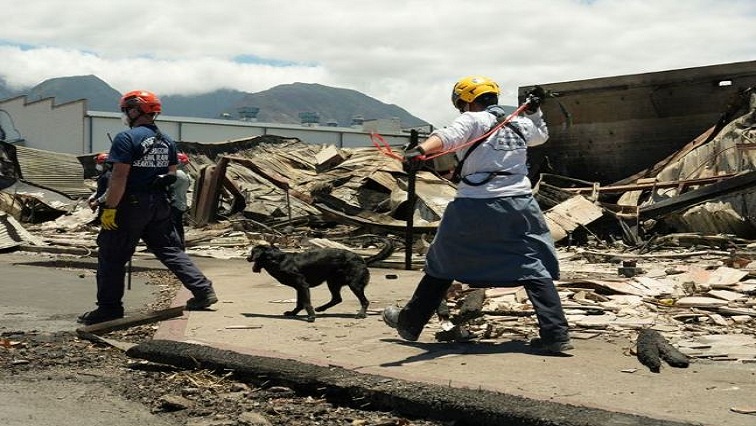A year of intense training to discern the difference between human and animal remains is a must for the specialized search dogs deployed in the treacherous conditions on Maui following last week’s deadly wildfires.
Dogs also must be born with a particular personality for the job to find remains of the missing and help bring closure for anguished families, said Mary Cablk, an expert in detection and systems at the Desert Research Institute in Nevada.
Cablk has trained hundreds of canines, designed training programmes for handlers and still goes out on dozens of searches ayear with her own dogs, although she is not involved in the Maui recovery operation.
“Dogs that really want to play, that are obsessive about their toy, that are confident and agile, that are not afraid of loud noises or weird surfaces, bring a lot to the table,” she said, explaining that getting to play with a chew toy is generally the dog’s reward for successfully locating human remains.
The wildfires that ravaged Maui last week killed at least 101 people, officials say, making it the deadliest US fire in a century.
The Federal Emergency Management Agency’s (FEMA) urban search rescue teams had 20 dogs on the ground as of Monday supporting state and local officials combing through the ashes,and FEMA Administrator Deanne Criswell told reporters at the White House on Wednesday the number would rise to at least 40.
“Because of the conditions and the fire debris, the dogs have to navigate the heat; they have to deal with issues with their paws walking through glass and debris. And in these conditions, the dogs require frequent rest, which is why we are sending in additional dogs to augment the operation,” she said.
Jeremy Greenberg, FEMA’s director of operations, under scored that while searchers understand that families are desperate to know the fate of missing loved ones, they must “conduct that search in a safe and respectful manner.”
DIFFICULT TERRAIN
Each cadaver dog can search the burned down “footprints” of up to a couple dozen homes each day, depending on conditions.
Hawaii’s government has said at least 2 200 tructures were destroyed in the fires; 86% were residential buildings. Dogs that will work fire scenes are trained to detect burnt flesh, and can distinguish human remains from those of pets and other animals.
The dogs are also taught to lie down once they have found something, Cablk said, not become excited and run back and forth to a handler, which could damage a scene.
Dogs are also now being trained not to enter the “footprint” of a burned down house at all, but to signal to handlers that they have hit upon remains without approaching them.
That training came from lessons learned in deadly wildfires in California in recent years, such as the Paradise, California Camp Fire in which 86 were killed.
“It used to be that people would just go in and they would look, they would rake, they would shovel, and it made the job of the forensic anthropologists more difficult. “You ended up with remains that were more difficult to identify. And where you had multiple individuals together, those bones got commingled, making the job of investigators even more difficult,” Cablk said.
Just as cadavers are used to teach medical students, Cablk said, trainers use human flesh and blood to train dogs.
Some countries do not allow human remains in such training, so dogs must be taught using animal remains, making rescues more difficult as dogs will give an alert for both animal and human corpses.
Cadaver dogs are trained to associate the scent of human remains with a reward, typically a chew toy, Cablk said.
“That’s the dog’s paycheck,” Cablk said. “Handlers will carry the reward toy with them, and many dogs, in fact, will come around to the back of the handler and check to make sure that the toy is in their pack.”


